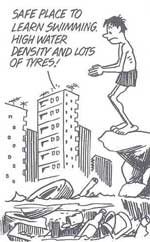Global State of National Urban Policy 2024
<p>With global population increasingly concentrating in urban areas, cities are driving national economic growth, while also grappling with challenges such as inequalities, affordable housing shortages,
<p>With global population increasingly concentrating in urban areas, cities are driving national economic growth, while also grappling with challenges such as inequalities, affordable housing shortages,

TODAY, the gloomy scenario of blurred faces framed in countless tenement windows seems to have wafted right out of an Eliotsian elegy into the equally foggy reality of urban existence in the

The wetlands of Bangalore are falling prey to rapid urbanisation, according to a paper prepared by a group of researchers. The report says urbanisation is also affecting water quality. It notes the
THERE is something very beautiful about lakes -- not just aesthetically, but also intellectually. Lakes do not just mirror their environment. They also mirror the society around them. Clean water

A POPULATION expert sharply critical of India's achievements in curbing population growth. A demographer with scant respect for the census. A statistician who finds prevalent statistics misleading. A professional researcher who would rather rely on visual

IN A SITUATION where material on environmental law is by and large scattered, the bringing together of case, statutory and analytical material, through careful selection and critique, is of
AN INDICATOR of a society's level of development is the quantity and quality of the energy it consumes. This is made clear by the wide disparity in per capita energy consumption in industrialised and

City Life, a compilation of films from different parts of the world, vividly depicts the trials and tribulations of urban society.

CALCUTTA maidan -- at 294-ha, the largest public ground in the teeming metropolis, is in danger of being developed as commercial property by the Indian army. The maidan belongs to the army's eastern

INDIA has been witnessing an explosive urbanisation. The percentage of total population living in urban areas increased from 17.3 in 1951 to 25.7 in 1991. But during 1981-91, the annual rate of urban
The report, "Environmental and Energy Sustainability: An Approach for India", identified clean power and energy-efficiency measures as having the largest potential impact on emissions, with the capability to reduce CO2 output 28 to 34 per cent by 2030.